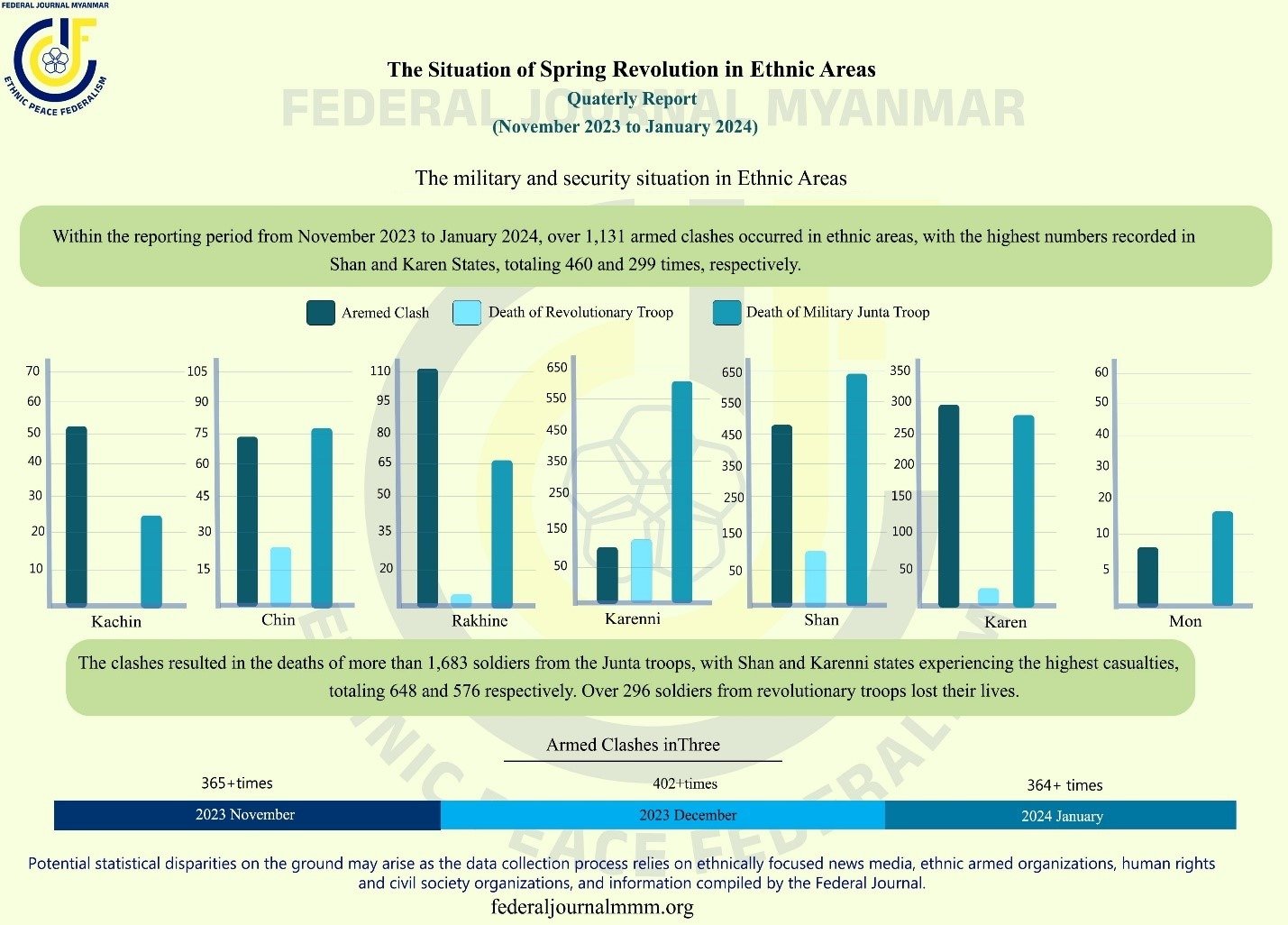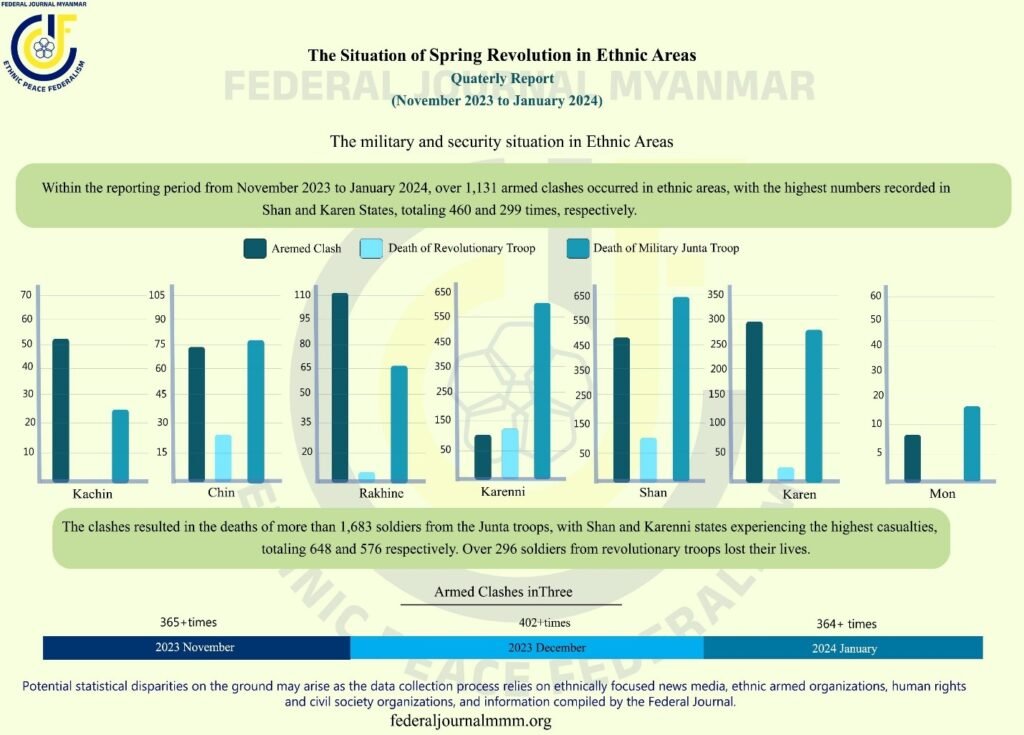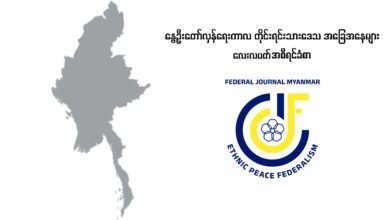
The situation of Spring Revolution in Ethnic Areas
Quarterly Report (November 2023 – January 2024)
The Federal Journal-Myanmar collects and publishes monthly and quarterly reports pertaining public activities, movements and coordination in resisting the military junta in Myanmar. By this time, the report is focused on the political dynamic and conflict development within the past three months by examining about casualties in both sides (military junta and resisting groups) due to conflict incidents, destruction of civilian structures due to the Junta’s operation, displacement in Ethnic areas from November 2023 to January 2024.
Part (I)
The military and security situation in ethnic areas
During the past three months, from November 2023 to January 2024, a total of 1,131 small and large-scale armed clashes have broken out between the SAC’s troops and resistant forces.Notably, Shan and Karen States experienced the highest frequency of clashes, with 460 and 299 incidents respectively.
All the while, more than 1683 troops of SAC were killed in clashes by the resistant groups in ethnic areas. Shan State recorded the highest number of casualties with 648, followed by Karenni State with 576. Meanwhile, 296 soldiers from the revolutionary forces also lost their lives in the incidents.

(a) Kachin State
During the reporting period, 53 armed clashes occurred between SAC and the Kachin joint Resistance Forces, resulting in 25 deaths among SAC troops. Fatalities among the resistant groups were not reported during this period.
The Kachin Joint Defense Forces conduct their armed operations in accordance with the military command and directives of the Kachin Independence Army – KIA. Their operations span various locations including Shweku, Pu-tao, and Phankant Townships in Bhamo District, as well as border areas between Kachin and Sagaing such as Katha, Indaw, Kawlin, and Tigyaing townships. Additionally, they operate in northern parts of Shan State, including Kutkhaing, Muse, Pyin-Oo-Lwin, and Naungcho Townships.
(b) Chin State
During the reporting period, a total of 73 clashes took place between the SAC and the Chin National Army – CNA, as well as the clashes between SAC and joint forces of CNA and Chinland (Chin) Defense Forces in Chin State and its border areas. Within this timeframe, 76 SAC troops lost their lives, along with 25 revolutionary troops.
The Chin National Army – CNA plays a pivotal role as the primary armed actor in Chin State and has been collaborating with other emerging township or tribal-based defense forces as required. Additionally, the Chinland joint defense forces have been actively conducting military operations, particularly in Chin State and its border regions, including areas such as Kankaw in Magway region and the Kalay-Kabaw areas of the northern Sagaing region.
(c) Rakhine State
A total of 111 clashes between the Arakan Army – AA and SAC occurred, resulting in 67 deaths among SAC troops and 4 fatalities among resistant groups.
The operational scope of the Arakan Army – AA has extended beyond its traditional areas of activity in Rakhine State and the northern regions of Shan State. It now encompasses Htilin Township in Sagaing Region and Paletwa Township in Chin State, marking a significant geographical expansion of its military activities.
(d) Shan State
The highest number of clashes and fatalities among SAC troops were recorded in Shan State during this reporting period, with a total of 460 clashes and 648 SAC troop deaths. Additionally, there were 109 documented fatalities among resistant groups, marking the second highest number of casualties in this reporting period.
In Shan State, clashes occur between the SAC and an alliance consisting of three brotherhoods: Ta’ang National LIberation Army-TNLA, Myanmar National Democratic Alliance Army-MNDAA and Arakan Army-AA, the Kachin Independence Army-KIA, Karenni Joint Defense Forces-KNDF, and other regionally based People’s Defense Forces-PDFs. The majority of these clashes and incidents take place in the northern part of the state.
(e) Karenni State
During the reporting period, 128 clashes occurred between the junta force and Karenni joint Resistance Forces in Karenni State and its bordering areas. The casualties from the junta troops amounted to 576 deaths, marking Karenni State as the second highest in terms of fatalities of the junta troops during this period. Additionally, Karenni State witnessed the highest number of deaths among soldiers from the resistant groups, with 138 fatalities recorded.
In Karenni State, armed conflicts primarily involve between the SAC and Karenni joint defense forces ;Karenni Army – KA, the Karenni Nationalities Defense Forces – KNDF, and Karenni State-based Local Defense Forces. Additionally, the Karenni Joint Defense Forces carry out operations in itd bordering areas such as Phenkhon and Pinlaung townships in the southern parts of Shan State, collaborating with Local Defense Forces from Shan State.
(f) Karen State
During the reporting period, a total of 299 clashes occurred in the Kawthoolei Administrative Area. These clashes predominantly involved SAC troops and the Karen National Liberation Army (KNLA) along with its joint defense forces from the Kawthoolei Administrative Area. Throughout these confrontations, 276 junta troops lost their lives, while 20 revolutionary troops were also killed.
Local defense forces such as Tathon PDF, Pa-O PDF- (PDF-KD), People Defense Force – PDF, Karen Revolution Front – KRF, Mon State Revolutionary Force-MSRF, Kyaikhto Revolutionary Force-KRF, Yee Guerilla Force-YGF, All Burma Students’ Democratic Front-ABSDF (Thahton District), Special Operation Force – SOF, Yee Special Task Force – YSTF and the Karen National Liberation Army -KNLA jointly conduct the military operations with the military command and leadership of KNLA in the Kawthoolei administration area, the control area of KNLA including townships from Mon state such as Tathon, Bilin, Khyaikhto.
(g) Mon State
During the reporting period from November 2023 to January 2024, a total of 7 clashes occurred, resulting in 15 deaths among SAC troops and their affiliates.
As townships in Mon State, including Tathon, Bilin, and Khyaikhto, are integral parts of the Kawthoolei Administrative Area under the control of the KNU/KNLA, local defense forces from these areas, as well as other Mon State and township-based forces, conduct their armed operations under the leadership and command of the KNLA.
Part (II)
The Consequences of Conflict incidents over Civilians
(a) Destruction of Civilian Structure and Civilian fatality
In looking at civilian casualties, due to the airstrikes of the junta, indiscriminate artillery shelling of the junta’s forces, explosion of landmine and military clashes between the junta’s troops and resistant forces, it has been observed that a total number of 506 civilians lost their lives. Among these, 227 civilians were killed in Shan State, representing the highest number, followed by 97 in Karen State, 73 in Karenni State, 69 in Rakhine State, 27 in Chin State, and 13 in Kachin State, respectively.
As a result of indiscriminate artillery shelling and the torching of the junta’s forces, over 1640 instances of destruction to civilian structures were recorded during this reporting period. Specifically, 557 instances occurred in Shan State, 481 in Karenni State, 274 in Karen State, 196 in Rakhine State, 127 in Chin State, and 5 in Kachin State.

Part (III)
The activities of State and Ethnic Councils and Committees
(a) Chinland Council
The first Chinland Council Conference took place over three consecutive days, from December 4 to 6, 2023, at Victoria Base, the headquarters of the Chin National Front (CNF). A total of 215 representatives, including members from the Chin National Front (CNF), Chin Members of Parliament (MPs), stakeholders from the local and overseas Chin communities, as well as representatives from local defense and administrative councils, attended the conference.
The conference established the Chinland Council, comprising local stakeholders such as the Chin National Front (CNF), Chin Members of Parliament (MPs), and representatives from local defense and administrative councils with the aims to pursue self-determination, political and national equality, and contribute to the formation of the Federal Union and the democratic building process.
The conference approved the Chinland Constitution stating that the government of Chinland; Parliament of Chinland, the executive of Chinland and the supreme court of Chinland will be formed within 60 days of the conference. Following the conference, the government formation of Chinland was carried out under the direction of Chinland Council and the first council’s meeting was held on December 11, 2023.
References –
1. Independent Ethnic Based News Media
2. State/National based Interim Consultative Councils & Committees
3. Ethnic Human Rights Organization
4. Exclusive Interviews by Federal Journal Myanmar
Federal Journal (Myanmar)
——၀၀၀——-
the PDF file for Saving Read – CLICK HERE TO DOWNLOAD




